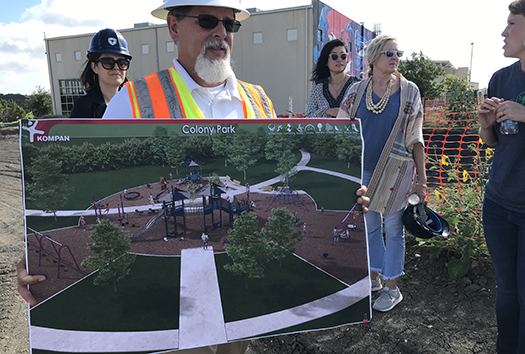
At St. David’s Foundation, we love parks. They are free community assets that help us get healthy, stay healthy and connect to us to one another, all while experiencing nature. It was out of this love that, a few years ago, we helped fund a wide range of healthy parks projects – from playgrounds to trails to community organizing.
One such project is Colony Park in northeast Austin funded via Austin Parks Foundation (APF). Next to both Turner Roberts Recreation Center and Overton Elementary School, it’s within walking distance to growing neighborhoods. It’s also overgrown, under-used, and ripe for renovation. After more than a year of planning and preliminary work, the former undeveloped piece of land is transforming into a prized community asset before our eyes. The park will include a full-sized soccer field, baseball field, and a top of the line playscape, along with plenty of walking trails, a mural and open green space. In July, APF hosted us for a hard hat tour of the work underway. It was early in the process, but we could already see just how valuable this park is going to be to the surrounding community.

We believe that all people in Central Texas deserve vibrant parks and that parks play an important role in a community’s public health strategy, but there’s still much work to be done. Though Central Texas is blessed with a relative abundance of green space, when it comes to meeting community park needs, Austin’s Parkscore ranks in the middle of our nation’s 100 largest cities due largely to lack of amenities and aging infrastructure. As one Central Texas resident put it, “There needs to be a diversity of opportunities in a park for all of the things you might be interested in, not just grassy lots.” Our rural areas have even more needs.
To help identify design standards for healthy parks and make smarter, more strategic investments, we commissioned a study with the Trust for Public Land (TPL). The project, called the Healthy Parks Plan for Travis, Bastrop and Caldwell Counties, engaged 2,000 local experts and residents and included the development of a geographic information system (GIS) analysis tool that can determine where new parks could have the greatest health impact, especially in rural and underserved communities. The complete report findings and tool can be found here. A few things we learned include:
- While infrastructure improvement is important, small things like shade, beautification, structured activities and water fountains make using parks both more practical and enjoyable for people.
- More than 50% of Travis County residents visit parks, yet in Bastrop and Caldwell counties, that number is less than 15%.
- Less than half of people using parks in Travis visit a park daily or weekly, and in Bastrop and Caldwell Counties, that figure drops to 22%.
- Park use among children is significantly lower in Bastrop and Caldwell Counties, where only 34% of the children visit the parks and recreation areas daily or weekly, and 32% of children seldom or never go to parks.
St. David’s Foundation recently offered a new funding opportunity called Parks with Purpose: Parks for Health and Equity, geared toward organizations and groups interested in partnering with us to bring the Healthy Parks Plan into action. The funding opportunity built upon data, resources and tools championed by the TPL study. This funding opportunity supports the Foundation’s broader effort to maximize parks in Central Texas for physical activity, mental well-being and community connection – with strong emphasis on equity and underserved communities. We’re committed to finding new ways to make Central Texas parks better and more accessible to everyone, and look forward to awarding grants later this fall toward that goal.

This story was published as part of the August 2019 St. David’s Foundation’s newsletter, The 411. View the full newsletter here.
Click below to read other stories from The 411: